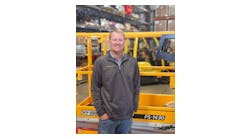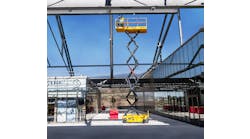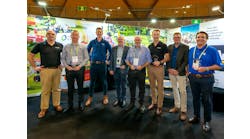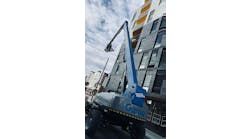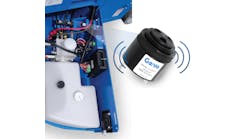RER asked Skyjack president Brad Boehler and Terex AWP’s senior director of marketing and product management Karen Stash for their insights into product development, safety trends and future industry growth.
What is new in your company’s aerial work platform offering?
Boehler: Our latest introduction is the SJ6832 Rough Terrain Electric.
We have been known as an industry leader in scissorlifts for decades. Skyjack continues to specify its machines for rough terrain performance. To simplify operator and service training, the SJ6832 RTE was built on the same chassis as the existing diesel and dual fuel 68RT units. The ability for the unit to operate indoors and outdoors mean this rough terrain scissorlift can be the first machine on site and the last off, increasing rental companies’ utilization.
In comparison with conventional units, maintenance costs and time are reduced because of the elimination of the need to service air filters, fuel filters, oil filters and the need to carry out oil changes, belt adjustments and coolant changes -- all those laborious tasks associated with internal combustion engines.
It is also the first electric scissorlift in its size with 45-percent gradeability. And crossover symmetrical fourwheel drive as standard means the machine can operate on almost all jobsites.
The range-extending gasoline-powered genset option adds versatility, allowing it to be reliably used at greenfield construction sites with no AC power, or when multiple shifts do not allow sufficient downtime to complete a standard charging cycle.
Stash: We have recently introduced several new products including a Super Boom, a hybrid scissor and an updated compact telehandler. The Genie SX-180 boomlift for example is an engineering marvel with a platform height of 180 feet. The stowed length shrinks it down to a mere 47 feet and the retracted width to 98 inches making it transportable without special overwidth permits. The lift capacity is class-leading 750 pounds. The boom is suited for applications in the oil and gas industries, commercial construction, industrial construction and maintenance, wind farm applications, power stations and utilities and large metropolitan cities that require work at height.
The new Genie BE69 hybrid scissors series features two selectable operating modes to meet the needs of both outdoor jobsites with no onsite power, and indoor jobsites with noise and emission-sensitive environments.
We have also taken our best-selling telehandler to the next level by introducing a newly upgraded Genie GTH- 5519 compact telehandler. The Genie GTH-5519 is an ideal workhorse for today’s jobsites. As a general-purpose machine, it can fit into tight spaces, help unload trucks, and can efficiently carry tools such as augers and sweepers. The new unit was purposefully designed to offer a Tier 4 final engine to meet today’s emission standards. Not only does the new machine comply with the latest standards, but also incorporates a number of other improvements offering benefits to customers.
Also at the upcoming APEX tradeshow in June in Amsterdam we will announce two new booms. One is designed for outdoor construction and industrial applications. The new Genie Z-62/40 diesel articulating boomlift (the successor to the Genie Z-60/34 boomlift) combines impressive lifting versatility with zero tail swing, outstanding outreach and “up-and-over” positioning capabilities, with the benefits of significant enhancements and new design features. One such feature is the Genie Fast Mast system. This feature enables the boom to be moved from full height to below grade, and from below grade to full height with the secondary boom fully raised, allowing operators to ascend and descend more efficiently. Thanks to its two- or four-wheel drive, four-wheel steer option and Genie TraX track drive system, the new Z-62/40 boom is also highly maneuverable and smooth to operate on muddy or uneven ground.
There seems to be a trend towards larger booms. Obviously the JLG 185- foot unit and Genie’s 180-foot boom have raised the bar. On other levels, do you see demand for larger units?
Stash: There has always been a demand for bigger booms that offer more features such as increased height, long outreach and a large working envelope. As we develop better technology like the X-chassis and our 5-stage boom we are able to deliver on these requests by offering features like full outreach of 80 feet all the way up to 90 feet of height.
Boehler: From a Skyjack point of view we are extending our boom range. Twelve months ago we launched or SJ 63 AJ and plans are progressing on a new telescopic boom... watch this space!
But honestly, while we do have plans to design 100-feet-plus machines it is not an immediate priority for Skyjack.
What are some of the new safety features that your company has incorporated and what trends do you see in the safety area in the aerial industry?
Boehler: The European market witnessed a quite lively debate over the issue of entrapment caused by inadvertent operator error. Skyjack has a solid reputation for providing features that combine durability, quality, safety and serviceability. We work with standard bodies and health and safety organizations to evolve this ethos and our telescopic and articulating booms are designed with a range of safety features, in accordance with regulatory requirements. Mobile Elevating Work Platforms, when used as intended, in conjunction with appropriate training and familiarization have been shown to save time, and make “work at height” efficient, effective and safer than using traditional methods of access.
However, we recognized that in certain circumstances, there may be an additional requirement for “secondary guarding” to prevent possible inadvertent operation of controls in the event of contact with an external object.
Skyjack and industry bodies recognized that there is not a single solution and that is why uniquely amongst manufacturers we offer two systems, one electronic and one mechanical. By offering this choice, Skyjack allows the user to select the most appropriate solution to meet their specific needs based on a job specific risk assessment.
Both systems can be supplied factory fitted to new Skyjack booms or installed on existing equipment.
The SGE system features a sensor bar that when activated stops all functions in use and initiates an audio/ visual alarm. If the bar is activated for less than one second the audio/visual alarm will activate while the bar is being pressed, interrupting all functions. The alarm will turn off after the sensor bar is released and all functions will resume. If pressure is applied for more than one second the alarm will activate and the engine will shut off, halting all functions. In the case of an accident the ground controls can be operated to bring the platform to a safe place. In the case of an inadvertent activation the platform control box has a reset button which, when pressed, will allow the engine to restart.
The Skyjack SGM system features a protective steel structure that is designed to prevent the operator from being held against the controls in the event of a collision during normal operation ensuring the operator is not inadvertently engaging the machine controls. The system does not impair visibility and minimizes the impact on the platform, allowing unrestricted access to the work area.
Stash: Genie recently introduced the Genie Operator Protective Alarm system which interrupts boom movement, and sounds an alarm and causes a light to flash. It can be retrofitted to any Genie articulating or telescopic boomlift manufactured after 2002. It is now available as an aftermarket option but will soon be offered as a factory-installed option.
The system is designed to be as unobtrusive as possible to operators and features a pressure sensitive horizontal bar that is fitted at around waist height below the boomlift’s control panel. When pressure is placed on the bar, as may be the case if an operator makes contact with an overhead obstacle, the system is activated. The system also features a reset button that can be pressed if the system is inadvertently activated.
Genie will also continue to offer the Operator Protective Structure. Introduced in 2012, the Genie OPS may be attached to boomlifts with 6-foot to 8-foot platforms. The tubular steel structure is designed to transfer the kinetic energy into surrounding structures while maintaining a protected area for the operator. It weighs 36 pounds (16 kilograms) and is bolted directly on the boomlift’s platform; no modifications are needed and both systems may be used together.
How is Tier 4 impacting the aerial work platform industry?
Stash: From supplier to end user, the industry has adopted Tier 4 Final engines across the product lines. As with any new technology, companies needed to learn the new technology, but it is being recognized as an overall benefit to the environment. In fact, in some cases, the performance of these engines is better than before and with fewer emissions and better error code diagnostics.
Boehler: We need to applaud anything that leads to environmental benefit. In many cases these challenges provoke advances that would not have otherwise been made. The overall impact has been one of adding to product development time and ultimately product development cost. Skyjack see our customers as partners and feel duty bound to spend significant resource of cost reduction to mitigate the upward trend, but I have to be honest and say that’s not always possible. But I think Skyjack has done better than most. Part of that ability has come from our core philosophy and a belief in keeping simplicity and reliability at the center of the process so that rental companies can minimize down time and maximize return on investment.
What do you expect will be the next growth area in the rental industry for aerials, i.e., low-level access machines, truck-mounted units, alternative fuels, etc.?
Boehler: That’s a good question! The industry in North America is pretty buoyant. The American Rental Association is forecasting positively with equipment rental posting another impressive year of growth in 2013 and projected to grow by 7.8 percent in 2014. So I think rather than a particular machine type or technology in the short term the focus is on fleet renewal and growth and to me that means a focus on their potential return on investment. Having said that, the technology used in the SJ6832 RTE mentioned earlier may find more applicability in other products.
Stash: The rental industry is always in need of better fleet management, including tracking and serviceability of units. Telematics solutions that are flexible and allow rental companies to better manage their fleet is one trend that is gaining traction.


